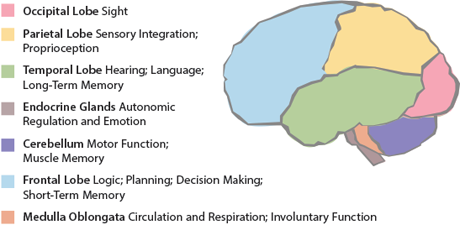Web site: Comparative Neuroanatomy and Intelligence
Web site: WebMD's Brain & Nervous System Health Center
Web site: Franklin Institute, "The Human Brain"
Learning 21st century skills means fine-tuning your brain. Let’s begin by examining a few myths and facts about the brain.
Your brain weighs only three pounds but requires 20 percent of the energy your body uses. That makes it the highest-maintenance organ in your body. The cost is worth it. Your brain is more powerful than a supercomputer. The facts about your brain are more amazing than the myths:
Myths |
Facts |
|
I use only 10 percent of my brain. |
You use all of your brain, just at different times. |
|
My left hemisphere is logical, and my right hemisphere is creative. |
Your left brain controls the right half of your body, and your right brain controls the left half; but logic and creativity stem from both hemispheres. |
|
I have a set number of neurons, and they never grow back. |
Your brain is constantly growing new neurons and making new connections. You can change your IQ, up or down. |
|
Modern technology makes me less smart. |
Modern technology does rewire the way your brain works, but thoughtful use of technology can actually make you smarter. |
|
My brain works best under pressure. |
Excess pressure reduces performance. Your brain needs nourishment, sleep, safety, and social connection to work best. |
|
My brain works best without other people’s interference. |
Human brains are social. Your brain wants to connect with others. |
|
The best way to get smart is to do brainteasers. |
The best way to get smart is to use your brain to do things you want to do. |
|
There is no such thing as a sixth sense. |
There are more than five senses. Proprioception tells you where your body is in space. Nociception is the perception of pain. You have other senses, too, including a sense of balance. |
Your Turn Go to thoughtfullearning.com/h4 to find links to articles about these and other brain facts.
Let’s take a quick look at the brain’s parts and what they do for you. At any given time, many areas of your brain are firing. Consider this example: You walk into class (cerebellum and parietal lobe), see your friend (occipital lobe), wave (cerebellum), say “hi” and smile (temporal lobe, cerebellum, and endocrine glands), and make a joke about a movie you both saw (frontal and temporal lobes and endocrine glands). And you haven’t even sat down yet. 
Your brain processes many different types of information, each of which requires a specific kind of thinking:
Your Turn
Web site: Comparative Neuroanatomy and Intelligence
Web site: WebMD's Brain & Nervous System Health Center
Web site: Franklin Institute, "The Human Brain"
© 2014 Thoughtful Learning
